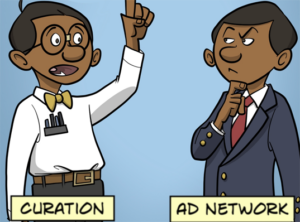 “Data-Driven Thinking” is written by members of the media community and contains fresh ideas on the digital revolution in media.
“Data-Driven Thinking” is written by members of the media community and contains fresh ideas on the digital revolution in media.
Today’s column is written by Ephraim (Jeff) Bander, president and chief revenue officer at Sticky.
More than a decade ago, Harvard Business School professor Gerald Zaltman reported that 95% of consumers’ purchase decision-making takes place in the subconscious mind without their awareness.
But to date, the majority of marketing studies have used only surface-level data from focus groups, surveys and campaign reports to glean various audiences’ motivations. This has created a massive gap in marketers’ knowledge of their consumers’ behavior.
Marketers are finally realizing that accessing this subconscious layer produces much richer insights and a more accurate picture of how advertising messages can emotionally impact a consumer, and not just if a consumer was provoked to click on an ad. Ad tech has come a long way in the past couple years, and there are now sophisticated tools that help marketers peel back new layers of the complex consumer.
Specifically, tracking an individual’s biometric and brain responses to ad exposure represent this next generation of data analytics. Brands and publishers could hugely benefit from this largely untapped field of science and its various methodologies to understand the true motivations behind all purchase decision-making.
In “Mad Men” days, Don Draper and his team would host extensive focus groups that relied on acute field observations and follow up surveys to learn how print ads or physical products affected consumers. To this day, major brands still employ focus group and survey methodologies to discern this information.
But focus groups and surveys alone are antiquated and ineffective because they only reflect what consumers can articulate as their own experience, and, as Zaltman reported, recall from 95% of consumers’ purchase decision-making takes place in the subconscious. In contrast, combining articulated responses with neuro and biometric measurements brings a scientific, data-driven discipline to explain why consumers make purchases, and what drives them to prefer one brand over another. While these methodologies and their applications are still in their infancy, studies such as these show how marketers can adopt some of traditional researchers’ practices to gain interesting consumer insights and inform strategic campaigns.
For example, through a combination of biometric and neuromarketing research, studies have found that using images with curved edges in marketing and advertising perform significantly better at creating positive, approachable brand associations with consumers than pointed edges. In 2004, global cosmetics brand Lancôme embraced this finding in a $300 million global rebrand effort. Lancôme replaced its main symbol of a rose to a bold signature that looked like it was written by a creative, assertive woman in such a hurry that she renders the circumflex over the ”o” in ‘Lancôme’ as curved rather than pointed. ”Building the campaign around the idea of a handwritten signature is part of the more natural, more emotional approach,” said Natacha Dzikowski, then managing director of Publicis 133, a unit of Publicis Worldwide.
As another example, there is an interesting biological fact that women have more “mirror neurons” than men – brain cells that respond equally when we perform an action to when we witness someone else perform the same action. Think of the yawning effect where one may yawn shortly after observing someone else yawn. Researchers have seen a correlation to women’s emotional connection to marketing: Studies report that women respond more favorably to ads that show more social interactions than ads that show people by themselves.
This only scratches the surface of how new biometric and neuromarketing tools have the potential to change the landscape, in terms of how marketers can use data to strategize, build and optimize content and campaigns. This not only applies to brands with commercial objectives, but also applies to larger, global communities of marketers passionate about shaping more positive outcomes with social, economic and health-related causes.
As the industry becomes more familiar with the value that this next generation of data will bring and demand increases, affordability and the automation of biometric and neuromarketing methodologies will be vital to scaling market adoption. When technology partners overcome these challenges, it won’t be long before these new types of insights become catnip for brand advertisers who want a deeper understanding of their consumers’ emotional profiles.
Follow Ephraim (Jeff) Bander (@Stickyadman), Sticky (@sticky_ad), and AdExchanger (@adexchanger) on Twitter.











